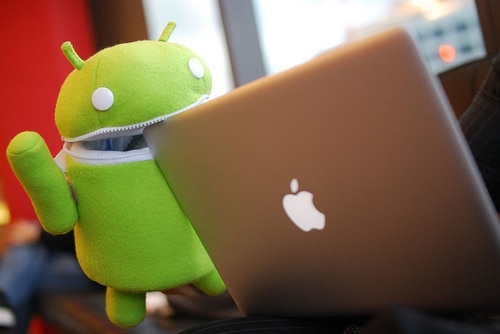
Publishers are increasingly confident about the prospects for tablet editions in the post-print area. But, when it comes to actually monetising the opportunity, Android’s limitations mean iTunes Store remains the only real game in town for the forseeable future.
Android-powered tablets are now shipping from several manufacturers and, if they follow the smartphone pattern, will begin outnumbering Apple’s iOS slate. But, whilst publishers are taking the opportunity to sell paid editions through iPad’s on-board app store, Google (NSDQ: GOOG) is restricting many makers of Android tablets from embedding the system’s equivalent Market store.
It leaves publishers without an equivalent, coherent on-board payment ecosystem through which to sell. That’s one reason why, while the number of publications on iPad is booming, you will find precious few on Android.
As we reported in September, though iPad upscales iPhone apps for its larger screen, Google limits Market availability from many tablet makers, saying: “You can have Android Market if it leads to a good implementation.”
Though Google’s Android Compatibility Test can automatically mandate makers of smartphones, makers of Android devices with screens larger than 5.8 inches diagonal, or 480×854 pixels, “MUST” contact Google’s Android Compatibility Team in person, according to the compatibility guidelines. At the least, that likely slows down the development process.
“Setting up a paid in-app subscription is definitely harder on Android because of their commitment to wanting to do things more through the carriers,” says Nic Newman, managing director of tablet developer Tigerspike, which has made seven tablet editions for News Corp (NSDQ: NWS) as well as for other publishers.
“Designing for Android is way more complex than designing for iPad. There are not just three- and 10-inch devices but also a number of different aspect ratios. It has a number of publishers scratching their heads. It’s not as obvious to publishers how they can make money easily through Android as with iPad – it’s a choice of one or the other. The road to monetisation on Android is a lot more complex.”
This relatively difficult Android experience is prompting some publishers to recast their tablet strategy through a more web-centric lens….
The Financial Times, which already had a custom iOS app, has brought its subscription news app to Google’s system using an app that’s mainly a wrapper for content rendered in HTML5. Product manager Steve Pinches now says: “We see touchscreen as a broad category. From a product perspective, different versions will be the same product, with different UIs for small, medium and large screens – OS-neutral.”
In a similar way, the BBC aims to develop only HTML versions of its iPlayer, to ensure usability across a burgeoning array of devies.
Similarly, German newspaper Zeit, which already had an iPad app edition, has now debuted a version of its website custom-designed for tablets generally. The site has been billed as an iPad-specific web version but, as Zeit acknowledges, the happy side-effect is that it works on all such slates, like the coming, confusing wave of Androids.
Just as the abnormal dimensions of its Galaxy Tab meant Samsung had to work directly with Google to make it one of the few Android tablets to carry Market, so, too, The Financial Times had to ride the device maker’s coat tails to bring its app to Android. It recently secured a bundling deal on the Tab for its new Android app, which it says, however, “will run on any small screen or midi-tablet devices”.
This process, whilst seemingly more difficult than developing for iPad, is nevertheless informing how the FT goes forward on a range of devices. Pinches adds: “We have just released the app to Android Market for large screens and are working on a small-screen UI, which will be out very soon – this will be the core platform for mobile.”
For Zeit’s developer, iA, being pushed toward tablet delivery via web is a positive, not a negative. “Print publishers got excited about apps because they finally opened a door to charge for content,” CEO Oliver Reichenstein writes. “But developing an HTML-based news app is not just cheaper and faster, it also gives you more editorial and technical control over your contents. More importantly, HTML-apps are in many ways more convenient for the user.”
Such editions reconnect readers with the web from whence they came – the same web which many publishers have found it hard to profit from. If Android cannot mimic iOS, many publishers may either be unable to start charging for content as hoped on tablets, or will need to take care of payment processing themselves, picking from PayPal and direct credit card billing.
Tigerspike’s Newman, whilst acknowledging the challenges, sees cause for optimism, just not yet: “You’ve got a number of different Android versions out there. It’s only really when we’ve got Honeycomb [a future upgrade] we will have the right operating system for tablets.”